Witnessing someone engaged in rapid taps and swift movements on their mobile device in a public setting often signals their immersion in a hyper-casual game. Defined by their straightforward and engaging gameplay, hyper-casual games stand out for their ability to captivate players through concise and energetic game sequences. These games are designed to appeal broadly, offering instant enjoyment to a diverse audience ranging from occasional players to those seldom engaging with mobile gaming platforms.
The significance of game mechanics in this category cannot be overstated. The allure of hyper-casual games lies in their uncomplicated yet compelling mechanics, central to their mass appeal. An impressive figure is the annual occurrence of over 167 million sessions of hyper-casual gameplay, highlighting the genre's vast and active user base. Exploring the mechanics contributing to hyper-casual games' success offers valuable insights. Furthermore, understanding these mechanics can be instrumental for developers looking to integrate similar principles into their upcoming creations.
Hyper-casual game mechanics, characterized by simplicity and dynamism, are pivotal in crafting games that resonate with a broad audience. These mechanics ensure that games are accessible yet addictive, providing instant gratification and a satisfying sense of progression. The ability to quickly grasp the game's objectives and controls makes hyper-casual games appealing, ensuring that players can dive into the gameplay without a steep learning curve.
By dissecting and applying these game mechanics thoughtfully, developers can generate fresh ideas that harness the essence of hyper-casual appeal, potentially replicating its widespread success in their projects.
The Substantial Role of Gestures
The engaging allure of hyper-casual games often stems from their innovative use of intuitive controls and interactions. These games, predominantly experienced on mobile platforms, harness a variety of input methods, incorporating both direct contact with the device's screen and the more nuanced manipulation of the device itself.
 |
 |
 |
 |
 |
 |
| Tap | Swipe | Press | Pinch/Spread | Drag | Contactless |
The simplicity and directness of these interactions are critical to the hyper-casual genre's broad appeal, allowing players to understand and engage with the game's mechanics quickly. Among these, tactile gestures such as swiping, tapping, and dragging are prevalent, providing an immediate and responsive means for players to interact with the game environment.
However, an often underutilized aspect within hyper-casual game mechanics is the employment of contactless controls. These innovative approaches extend the gameplay experience beyond the confines of the screen, leveraging the sophisticated capabilities of modern smartphones. A prime example is integrating the gyroscope sensor, a standard feature in contemporary mobile devices, which can detect and interpret the device's orientation and movement.
By utilizing the gyroscope, developers can introduce a layer of physicality to the gameplay, inviting players to tilt, rotate, or shake their device as a means of interaction. Incorporating physical movement into game mechanics opens possibilities for creative ideas, enhancing the immersive quality of hyper-casual games and offering a refreshing departure from traditional touch-based controls.
The exploration of such game mechanics not only enriches the player's experience but also showcases the versatility and innovation inherent in hyper-casual game design. By broadening the scope of interaction to include the physical manipulation of the device, developers can craft more engaging and dynamic gameplay experiences.
Such an approach capitalizes on the inherent capabilities of mobile devices, offering a more diverse and enriched gaming experience that can captivate and entertain players in new and unexpected ways. The strategic incorporation of these mechanics into hyper-casual games can significantly enhance their appeal and longevity, inviting players to engage with the game on multiple levels and through various modes of interaction.
Top Mechanics of Hyper-Casual Games
Although dozens of unique mechanics have made their way into hyper-casual games over the years, only a limited portion of them proved successful. We will be taking a look at the Top 7 that make the cut in the greatest number of applications.
Swerve Mechanics
Mastering the art of swerving is essential for the compelling dynamics of hyper-casual games, particularly when directing a character or vehicle across a well-built course. The gist of this technique presupposes executing gradual and deliberate turns, ensuring that the momentum does not propel the entity off the course.
Given the constant forward thrust inherent to many of these games, where halting is not an option, players must perform calculated and extended maneuvers instead of pausing the gameplay. These maneuvers enable the controlled entity, be it a car or a character, to navigate turns with precision and fluidity, enhancing the gameplay experience significantly. Various track elements, such as speed boosters, are adding an intriguing layer to the game mechanics, which introduce sudden accelerations, compelling players to adapt their real-time strategies.

A notable example that encapsulates these hyper-casual game mechanics is Drifty Race. In this game, players are pitted against AI competitors, aiming to maneuver their vehicle to victory by mastering the art of drifting and executing seamless turns. The inclusion of such mechanics not only amplifies the thrill of the race but also demands a higher level of engagement and skill from the players, making each successful turn or drift a rewarding achievement.
The challenge of swerving, coupled with the strategic placement of obstacles and boosters, significantly elevates the player's experience. The immense satisfaction derived from navigating through these intricacies, avoiding pitfalls, and crossing the finish line. It underscores the player's ability to maintain composure, demonstrate precise control, and be keenly aware of the game environment.
These aspects are fundamental to hyper-casual games, where the depth and sophistication of the gameplay mechanics enrich simplicity in design. As players refine their swerving techniques and overcome the hurdles presented, they progress within the game and develop a deeper appreciation for the intricate balance of simplicity and complexity that defines the hyper-casual genre. This balance keeps players engaged, continually testing their skills and pushing the boundaries of their reflexes and strategic thinking.
Turn Mechanics
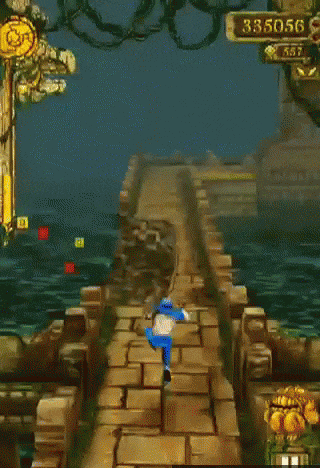
The dynamics of hyper-casual games often incorporate an element of instantaneous directional change, compelling players to adapt rapidly to evolving scenarios within the gameplay environment. As players navigate their character or object along the game's path, they encounter sudden deviations that necessitate a swift adjustment in their movement strategy. These abrupt changes can occur vertically or horizontally, demanding quick reflexes and strategic foresight from the player.
Twist. The game introduces unexpected changes in direction, requiring players to adapt their movement quickly to align with the new path.
Quick decision. Players must make immediate choices to alter their trajectory, ensuring it coincides with the game's evolving layout.
Alignment. The key is to synchronize the character's or object's movement with the track's twists and turns, maintaining the game's flow and momentum.
A quintessential example of these hyper-casual game mechanics in action is seen in the widely acclaimed Temple Run. This game epitomizes the genre's core principles, where players guide the protagonist through a labyrinth of sharp turns and sudden shifts, epitomizing the essence of hyper-casual gameplay. Executing quick turns underscores the need for constant vigilance and precision, ensuring the hero's continued sprint through treacherous terrains.
The allure of such game mechanics lies in their ability to keep players perpetually engaged, with attention unwaveringly fixed on the screen. The slightest lapse in concentration could derail the progress painstakingly achieved, making the gameplay both exhilarating and unforgiving. Players are thus incentivized to maintain close interaction with the game, their fingers poised for action and eyes scanning for imminent changes in direction.
Achieving mastery over these swift directional shifts propels players forward in the game and serves as a testament to their quick reflexes and adaptability. It's these moments of triumph, when players deftly navigate the game's challenges, that they can take pride in their agility and responsiveness.
Such achievements resonate deeply within the community of hyper-casual gamers, fostering a sense of accomplishment and a desire to hone their skills continually. The integration of these mechanics into hyper-casual games enriches the gameplay experience, offering a blend of simplicity and depth that challenges players to remain alert and responsive at every turn.
Rise/Fall Mechanics
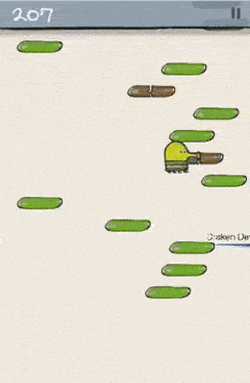
In hyper-casual games, continuous upward or downward movement forms the core of the gameplay, compelling players to guide a character or object through an endless array of obstacles. The challenge involves maintaining constant motion; any halt in the ascent or descent signals the end of the current session. A prime example of this mechanism is seen in Doodle Jump, where the player's objective is to navigate the protagonist ever higher across a succession of platforms.
Continuous motion. The focus of the game revolves around keeping the character or object in perpetual motion, avoiding any pauses that would lead to the termination of the round.
Obstacle navigation. Players must adeptly avoid hindrances that impede their upward or downward journey, ensuring the character's uninterrupted progression.
Endless exploration. The game's structure encourages an insatiable curiosity to discover what's beyond the current horizon, whether it be new rewards, artistic elements, or challenges.
The allure of the rise and fall mechanic taps into a fundamental human instinct to explore and conquer unknown territories. As players progress, the game unveils new vistas, rewards, and challenges, each more enticing than the last, ensuring players remain engaged and eager to push the boundaries of their abilities.
The thrill of surpassing previous achievements and the anticipation of uncovering novel aspects of the game with each successful move create a compelling cycle of reward and motivation. This mechanic enriches the gaming experience and fosters a sense of achievement and continuous engagement, driving players to extend their sessions and explore the game's full potential. Through this, hyper-casual games like Doodle Jump manage to captivate and retain a broad audience by offering simple yet profoundly engaging game mechanics.
Stacking Mechanics
Stacking emerges as a compelling gameplay mechanic, inviting players to construct towering edifices by judiciously placing one element atop another. The essence of this gameplay lies in the strategic layering of components to achieve towering heights, with each piece's placement critical to the structure's overall stability and the game's progression. Knight – Stack Jump serves as an exemplary illustration of this mechanic in action, where the player guides a knight on a valiant quest upward, leaping from one ascending platform to the next in an effort to save a princess.
Strategic placement. The game demands meticulous attention to the alignment of each segment, ensuring the edifice grows and remains viable as it ascends.
Timed leaps. Success hinges on the player's ability to judge the perfect moment for the knight to jump, securing a new level in the ever-expanding tower.
Evolving challenge. With each successful jump, the anticipation of scaling new heights and setting new records grows, driving the player forward.
The allure of stacking within the hyper-casual domain taps into the innate desire for visual and tangible achievements. Erecting a structure that surpasses previous attempts or outmatches those of friends brings a profound sense of satisfaction. As the tower stretches skyward, losing count of the individual layers becomes inevitable, yet the eagerness to discover the final height at the round's culmination still needs to be renewed.
This gameplay mechanic not only provides instant visual gratification but also encourages a cycle of continuous improvement and strategic planning. Through games like Knight – Stack Jump, hyper-casual titles showcase their ability to offer simple, intuitive gameplay experiences rich in engagement and challenge, compelling players to enhance their skills and achieve new personal bests constantly.
Merge Mechanics

Hyper-casual games often feature the engaging mechanic of merging, where numerous elements displayed on the screen can be combined into a single entity. This fusion can occur instantaneously, requiring quick reflexes, or it might involve a deliberate choice of specific elements to merge, introducing a strategic component to the gameplay. The iconic Snake game, a staple on early mobile phones, serves as a prime example of this gameplay mechanic in action.
Element fusion. Players are presented with various items across the play area and tasked with combining these to advance or evolve their current state within the game.
Strategic selection. Choosing which elements to merge is crucial, impacting the game's progression and the player's success.
The appeal of merging mechanics within hyper-casual games lies in their ability to create evolving gameplay dynamics. Initially, players enjoy a broad leeway to navigate and expand within the game environment. However, as the game progresses and their in-game avatar or object grows, the increased size introduces new challenges. The once spacious environment becomes cramped, requiring more careful and thought-out maneuvers.
Each session presents a unique journey, starting from the simplicity and freedom of the initial phase to the increasingly complex scenarios that emerge as the player advances. This shifting dynamic ensures that no two rounds feel the same, keeping players intrigued about the potential outcomes of their decisions.
The continuous evolution of the gameplay experience, driven by the player's actions and the game's responsive mechanics, is a core element that sustains player engagement and interest in hyper-casual games. Through innovative ideas and simple yet deep game mechanics, games like Snake have cemented their place in the history of mobile gaming, offering timeless lessons in game design and player engagement.
Timed action Mechanics

The timing mechanic is a pivotal element, requiring players to execute actions at precisely the right moment to progress. This mechanic, while seemingly straightforward, demands acute attention and swift reflexes. The gameplay unfolds largely independently, with the primary requirement for player intervention being timely responses to ensure the game's continuity. A notable application of this concept is observed in Knight – Stack Jump, where the protagonist's objective is to ascend by leaping onto successive platforms. The crux of success in this game hinges on the precision of each jump.
Precision timing. The essence of the gameplay revolves around the player's ability to gauge the perfect moment for action, which is critical for advancing to subsequent levels.
Critical response. The challenge implies the player's capacity to react swiftly at crucial moments, a skill that becomes increasingly vital as the game progresses.
Initially, players find themselves engrossed in mastering the rhythm and pace of the game, dedicating their focus to identifying the optimal timing for each move. This learning phase is crucial, as it lays the foundation for the intuitive understanding players develop over time. As familiarity with the game's rhythm grows, the ability to anticipate and react to upcoming obstacles becomes second nature. However, the game mechanics are designed to escalate in complexity, with each passing minute introducing a faster pace and tighter windows for action.
The increasing speed of the game tests the player's adaptability and reflexes, pushing them to refine their timing and precision continuously. The satisfaction derived from successfully navigating these challenges fuels the player's motivation, driving them to achieve higher scores and surpass personal bests.
By integrating timing-based hyper-casual game mechanics, games like Knight – Stack Jump offer a dynamic and engaging experience that captivates players, encouraging them to hone their skills and push the boundaries of their capabilities. The allure of these games lies not just in their simplicity but in the depth of the challenges they present, making each round a unique test of timing, precision, and reflexes.
Match Mechanics
The matching mechanic, a staple in the hyper-casual gaming genre, hinges on the player's ability to identify and pair elements based on shared characteristics and visuals. This seemingly straightforward task requires players to repeatedly find and connect pairs until all possible matches are completed. In some instances, the game introduces an element of mystery by concealing these elements, compelling players to rely on memory and deduction to uncover matching pairs.
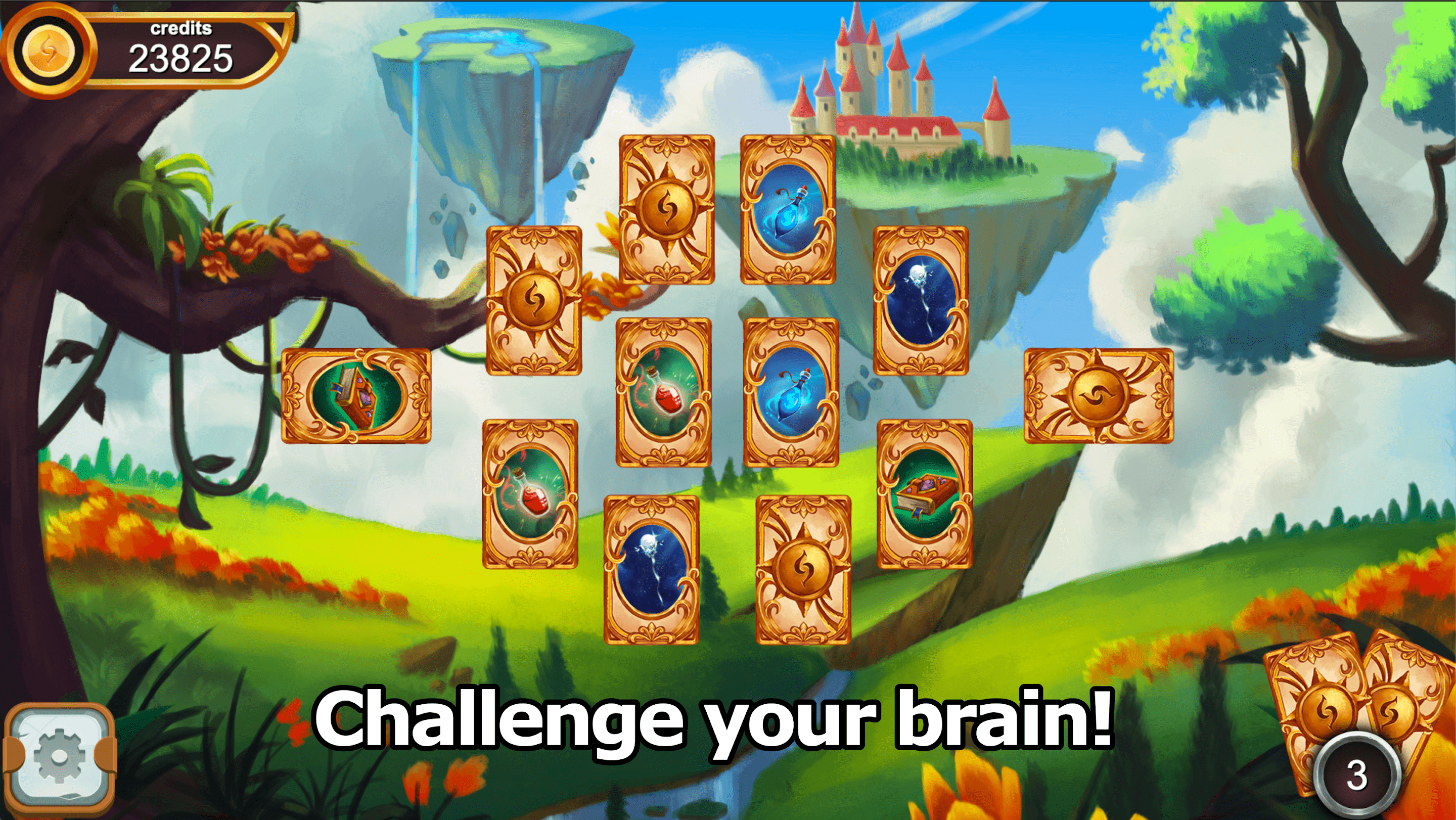
A misstep allows for an immediate retry, with the added challenge of recalling previously revealed elements and their locations. Magical Pairs exemplifies this type of gameplay, presenting players with a series of cards to be flipped one by one, testing both memory and strategy.
Visual matching. Players scan the game area, seeking elements that share identical features for pairing, a process that forms the core of the game's objective.
Memory challenge. The mechanic often conceals elements, adding a layer of complexity that requires players to remember the location and characteristics of each element they uncover.
Distinct from other hyper-casual game mechanics, the matching challenge uniquely incorporates a test of memory, urging players to learn from their errors and remember the positions of previously flipped elements. This aspect of gameplay entertains and stimulates cognitive functions, encouraging players to enhance their memory and attention to detail. The thrill of testing one's recall abilities and the satisfaction of completing a match without prior knowledge of the elements' locations contribute to the game's appeal.
Furthermore, the allure of matching games like Magical Pairs lies in their ability to blend simple, intuitive gameplay with mentally stimulating challenges. Players enjoy exercising their brains, improving their memory, and honing their intuition through gameplay. For some, these games become more than just a pastime; they serve as a tool for cognitive enhancement, with regular play contributing to sharpen memory skills and quicker decision-making.
Through innovative ideas and engaging mechanics, hyper-casual games offer diverse experiences that cater to a wide array of player preferences, combining entertainment with mental exercise uniquely captivatingly.
Push Mechanics

The gameplay element of moving objects to specific locations or displacing them from an area embodies a versatile mechanic in hyper-casual games. Players might find themselves tasked with strategically pushing an item towards a designated spot or propelling various objects out of their immediate vicinity, such as over an edge or beyond the confines of a delineated area.
The manipulation of these elements typically involves intuitive touch controls, where dragging a finger across the screen dictates the direction and force applied to the objects within the game environment. Strategic navigation and the need to execute turns to maneuver around obstacles or through mazes add layers of complexity and engagement. Push the Blocks presents a scenario where the protagonist is confined within a room, necessitating the rearrangement of blocks to predefined locations as a means of escape.
Directional movement. The core mechanic centers around the player's ability to guide objects towards or away from certain areas, demanding precision and strategic foresight.
Tactile control. The game employs touch-based interactions, allowing players to influence the movement of in-game elements through gestures directly.
While pushing objects might seem straightforward, its appeal within hyper-casual games extends beyond mere physical interaction. Players may derive satisfaction from the aesthetic pleasure of constructing intricate patterns or configurations with the game's elements. Others might approach the game as a puzzle, experimenting with various arrangements and strategies to achieve the desired outcome. Additionally, the physical act of moving heavy virtual objects can serve as an outlet for releasing stress or channeling latent energy in a focused and controlled manner.
The multifaceted nature of such game mechanics enriches the player experience, offering a blend of tactile engagement, cognitive challenge, and emotional release. Games like Push the Blocks capitalize on these aspects, providing a platform for players to explore creative ideas, solve complex puzzles, and indulge in a sense of accomplishment upon overcoming the challenges presented. By incorporating hyper-casual game mechanics, developers continue to craft experiences that resonate with a broad audience, ensuring that even the simplest actions, like pushing blocks, can transform into captivating and rewarding gameplay.
Clean Mechanics

The act of tidying up, often seen as a mundane chore in everyday life, transforms into an engaging and satisfying experience within the realm of hyper-casual games. These games cleverly simulate the process of cleaning and organizing, allowing players to indulge in the task of decluttering virtual spaces from the comfort of their sofa. The gameplay typically involves the player being placed in an environment that is initially in a state of chaos, with the objective being to methodically remove clutter, dirt, or any undesired items, thereby restoring the area to its original, unblemished condition.
Players can interact with the game elements through simple yet intuitive controls such as tapping, swiping, or dragging, effectively "cleaning" the virtual space. A prime example of this gameplay style is found in Chores!, a game that tasks players with a variety of domestic activities, from scrubbing surfaces in the kitchen to maintaining the garden by mowing the lawn.
Interactive engagement. Players interact with the game environment through direct actions, selecting and removing unwanted items to achieve a clean space.
Visual restoration. Transforming the cluttered space to a tidy one provides a visual reward, reinforcing the player's actions.
The allure of these cleaning-based game mechanics taps into a deeper psychological appeal, resonating with the innate human desire for order and the satisfaction derived from rectifying chaos. While physical cleaning might be deemed laborious by many, the virtual equivalent offers a sense of accomplishment without the associated exertion. The simple pleasure found in the act of decluttering in these games parallels the unexpected joy many find in popping bubble wrap; it's an activity that provides an inexplicable sense of satisfaction and completion.
Furthermore, these hyper-casual games capitalize on the universal appeal of transforming disorganized spaces into well-ordered ones, mirroring the gratification that comes from enhancing the aesthetics of one's surroundings. Through clever game mechanics and immersive tasks, games like Chores! offer a playful and therapeutic outlet, allowing players to experience the joy of cleaning and organization in a stress-free and entertaining context.
Reshape Mechanics
As a concept within hyper-casual games, resizing encompasses the strategic alteration of an object's dimensions and contour. This mechanic is often integral to gameplay, necessitating adjustments to an object's size or shape to navigate through confined spaces or solve puzzles. At times, these modifications must be executed swiftly to circumvent impending obstacles, adding a layer of urgency to the player's actions.
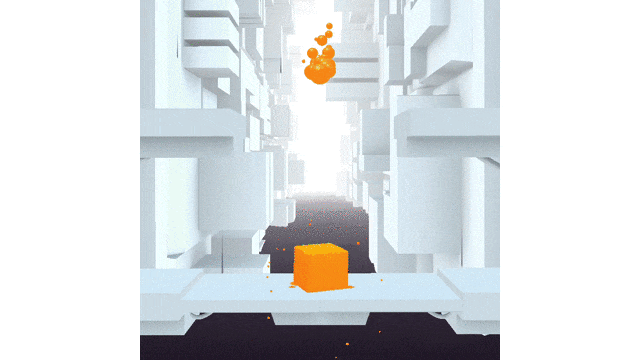
A vivid illustration of this mechanic at work is seen in Jelly Shift, where players guide a malleable jelly avatar along a course replete with a variety of hindrances, such as spikes, barriers, and slides. The key to success is in the player's ability to adeptly transform the jelly's form in real-time, ensuring it can glide through obstacles without becoming ensnared or tumbling off the path.
Adaptive transformation. Players are tasked with dynamically adjusting the avatar's shape to traverse through tight spots or bypass obstructions, making quick decisions to ensure continuous progress.
Puzzle-solving. The game intersperses puzzles that require thoughtful resizing of the avatar to fit into designated areas, blending quick reflexes with strategic planning.
This gameplay mechanic demands a blend of quick thinking and analytical prowess from players. Confronted with an upcoming obstacle, players are compelled to rapidly assess the situation, devising a strategy for altering their avatar in a manner that allows safe passage. The pressure of a ticking clock heightens the challenge, fostering an environment where players are keen to identify patterns and employ swift, effective solutions.
The resizing mechanic in hyper-casual games like Jelly Shift not only tests players' reflexes and decision-making skills but also encourages creative problem-solving. It's this combination of on-the-spot thinking and strategic planning that keeps players engaged, pushing them to continuously adapt and refine their approach to the ever-changing challenges presented by the game. Through inventive game mechanics and captivating gameplay ideas, hyper-casual games continue to offer fresh and exciting experiences that captivate a wide audience, proving that simplicity in design does not preclude depth in gameplay.
What they have in common
Looking at all of these mechanics, you will probably notice that most of them demand attentiveness and speed, and they rarely incorporate some complex strategizing. This is what defines hyper-casual games: they require minimal effort and thought coupled with maximum attentiveness and responsiveness.
Benefits of Using Hyper-Casual Mechanics
Beyond the ease of developing such mechanics, multiple advantages can be gained by development companies that implement them.
- Fast play sessions
- User engagement
- Simplicity leads to broad appeal
- Rewards
Hyper-casual games move at a fast pace. Most of the time, it takes up to 10 seconds to launch the app and start playing. Naturally, play rounds can carry on for different intervals, but the dynamic nature of the mechanics makes it incredibly easy to restart if the user fails the round. These pauses between rounds also serve as an ideal opportunity to insert advertisements and make money from the app.
Few users who have ever tried a hyper-casual title will deny that this type of app is very addictive. Given how easy the built-in features make it for users to achieve results, there is a desire to keep trying for a better result each round, with little downtime if they fail. Thus, users become very invested in the program and play it regularly. This dedication does not go unnoticed by app marketplaces and anyone who spends time with the users. Accordingly, the app’s popularity can quickly grow and hit the top of the charts within weeks of release.
When you open an app of this kind, it usually takes you one or two tries to grasp how the movements work and how you can score points. This is quite different from casual and hardcore releases, which are more difficult to get into. Hyper-casual games are appealing to people of all ages and countries, including preschoolers and elderly folks. It doesn’t take any kind of special skill to look at the screen and make simple motions at the right moments.
We did not mention this when listing the most popular features, but they are very often tied to rewards. For example, in a jumping game, jumping at the perfect time (as opposed to a good or acceptable time) can net you additional points or special currency that can be used for cool customizations. With rewards built into mechanics, playing becomes a rewarding experience that makes users feel good about their achievements.
How the Mechanics are Added
Mechanics are the rules by which your virtual world abides, so they are among the first things that are fleshed out in the development process. It all begins in the very first stage — planning, when the idea behind a project and how it will work are created and approved. Mechanics become tangible in the second stage of development – pre-production. At this point, the first prototypes are created and the basic flow of the game is tested for viability. Finally, the 3rd stage (production) polishes the mechanics and builds upon them to make the full experience.
In software
For example, Unity and Unreal Engine are two of the most popular engines for creating mobile games, and they each have different tools for building mechanics. In most cases, a fair amount of scripting is required to make the models and objects in your application move the way you want and generate the desired mechanics. The more complex the mechanics that you want to use, the more code will be needed. Thus, it is recommended that you have a skilled team of programmers and designers ready to work in tandem to make the mechanics in the game flow smoothly and look nice.
Hyper-Casual Game Development Services

If you have made up your mind to make a hyper-casual game, you might find it challenging, especially if you have not had any similar projects before. Rather than go on a hiring spree or spend months learning the basics of this kind of development, you can consider hiring a development partner. With hundreds of studios actively promoting their services, you should take the proper time to establish the reliability and qualifications of a development partner before you sign any agreements with them.
Game-Ace is a custom game development company with over 2 decades of experience in making games. We have completed projects of various scopes, from hyper-casual and instant games to big desktop and web titles for large player bases. For example, the aforementioned Knight – Stack Jump is one of our most recent entries in the hyper-casual genre, and it is available for free download on Android and iOS, so you are welcome to try it out.
We have the largest team of Unity-certified developers in Europe, and a large staff of 120+ people ready to jump into multiple projects. If you want to know more about what our clients think about us, you are welcome to check our profile on Clutch, a research agency that analyzes and collects data about thousands of companies around the world. We have a deep love for making fun games and accepting new challenges, so it would be a pleasure for us to discuss your project and how we can help. Just contact us at any time.
 How to Design Learning Games for Kids That Teach Real-World Skills
How to Design Learning Games for Kids That Teach Real-World Skills  Behind the Beeps: How Arcade Game Design Still Shapes Interactive Entertainment
Behind the Beeps: How Arcade Game Design Still Shapes Interactive Entertainment  Crafting Immersive Worlds: The Power of Game Environment Design
Crafting Immersive Worlds: The Power of Game Environment Design  Mastering Narrative Game Design for Unforgettable Player Experiences
Mastering Narrative Game Design for Unforgettable Player Experiences 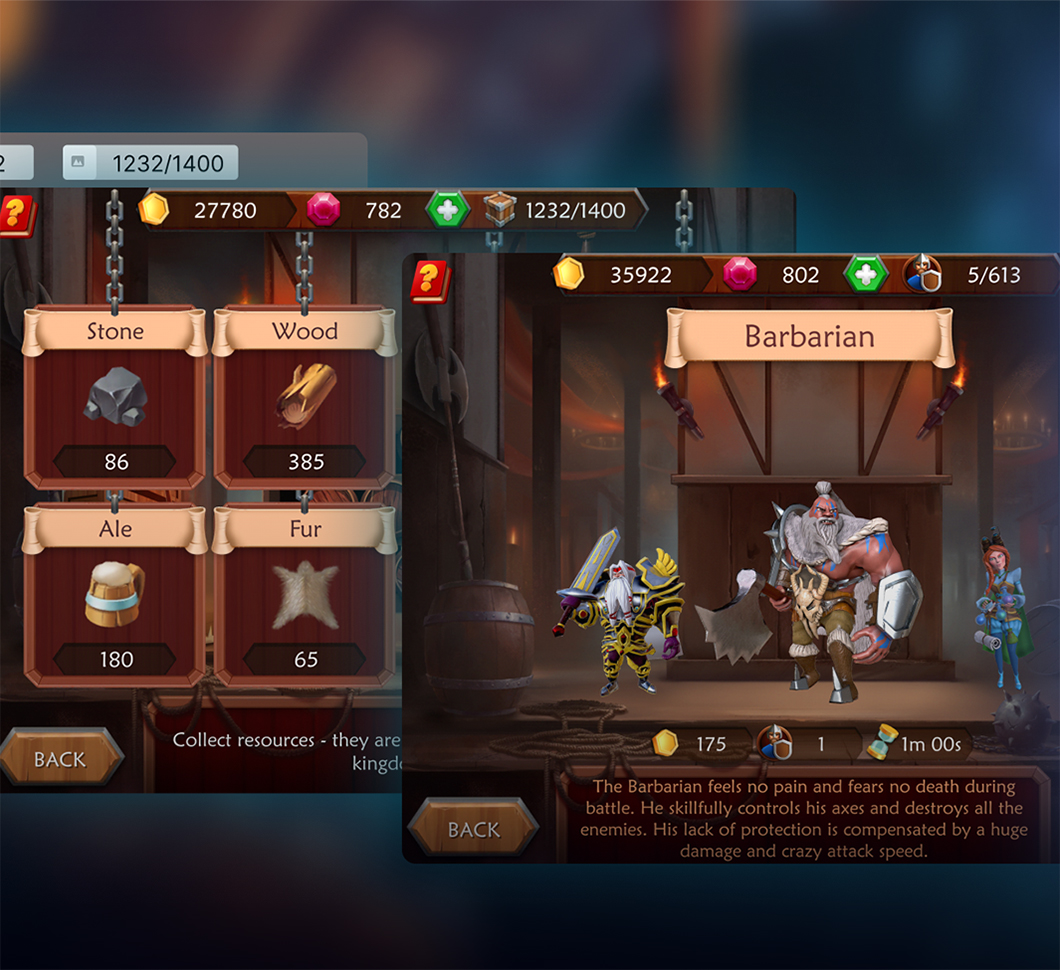 What Is Game UX? The Complete Guide for 2025
What Is Game UX? The Complete Guide for 2025 


































